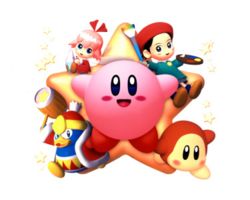Portal: Kirby

| |
| Kirby | |
| Developer | HAL Laboratory |
| Games | List of all games |
| Debut | Kirby's Dream Land (1992) |
The Kirby series is a platforming franchise that was created by Masahiro Sakurai. The Kirby games have been intentionally made to be simple and act as good games for beginners. The series features Kirby, a round pink character who has the ability to swallow enemies and steal their abilities. Although the series is primarily platforming, there have been other spin-off games which explored other genres, including a racing game.
History
The Kirby series was developed as a basic series since its inception as a handheld title, Kirby's Dream Land, in 1992. The first game introduced the character of Kirby, the primary antagonist King Dedede and the basics of the gameplay that would be utilized throughout the following games. This was followed by Kirby's first console game, which was Kirby's Adventure for the NES. This game added another new gameplay feature, which was Kirby's copying of enemy's abilities, and the mysterious Meta Knight was introduced. Adventure also became memorably darker at the end with surprise final enemy known as Nightmare.
Spin-off games such as Kirby's Avalanche and Kirby's Dream Course were released throughout the 90s, which showcased Kirby's versatility in other genres. This was accompanied by a continuation of the Dream Land name with Kirby's Dream Land 2 for the Game Boy in 1995 and Kirby's Dream Land 3 for the Super NES in 1997, both of which featured a group of animal buddies that would disappear from later games as well as a more sinister villain called Dark Matter. Prior to Dream Land 3, the more popular Kirby Super Star had been released for the Super NES in 1996. This game featured a remake of Kirby's Dream Land as well as a variety of new adventures and minigames of varying length. Super Star was notable as one of the few Kirby games that Sakurai was directly involved in following the initial two games. As for Dream Land 3, it was the last first party game put out by Nintendo following the release of the Nintendo 64.
HAL then began working on a new Kirby game for the Nintendo 64, although they were also busy starting the Super Smash Bros. series for this console. They eventually released the new game, Kirby 64: The Crystal Shards, for the Nintendo 64 in 2000. This game used a gameplay similar to the traditional platformers but rendered with 3-D graphics in a style often known as 2.5D. This teamed Kirby up with other characters: Dedede as well as Waddle Dee and Adeleine. Kirby 64 was also the last game to feature Dark Matter.
The series entered a slump during the Gamecube era, as the only Kirby game released for the system was the racing game Kirby Air Ride in 2003. This was also the last game Sakurai worked on before resigning due to the lack of freedom from working on constant sequels, but he remained supportive of HAL Laboratory. HAL did begin working on an actual Kirby adventure for the Gamecube, but it was either quietly cancelled or integrated into future Wii projects. Despite the lack of console games starring Kirby, there were still a steady amount of handheld titles. Kirby's Adventure was remade for the Game Boy Advance as Kirby: Nightmare in Dream Land in 2002 and it was followed by Kirby & The Amazing Mirror in 2004.
Kirby games continued on the Nintendo DS when it was released. In 2005, Kirby Canvas Curse was released with a unique gameplay scheme to capitalize on the DS's touch screen. This was followed by Kirby Squeak Squad in 2006, which was closer to a traditional Kirby game, and Kirby Super Star Ultra in 2008, which acted as an expanded remake of the classic Kirby Super Star. On the Nintendo Wii, Nintendo convinced Feel-Good to incorporate Kirby into a game they were developing, with the result being Kirby's Epic Yarn in 2010. This game once more featured a gameplay departure which was based around yarn and had Kirby transform into a variety of shapes in a storybook world. The more traditional Kirby Wii has since been confirmed, which may or may not be the same game which has been in development since the Gamecube era.
Other Media
In Japan, a gag manga called Kirby of the Star: The Story of Dedede Who Lives in Pupupu ran from 1995 to 2006. VIZ announced a localization of the manga in 2011, but it since took the announcement, which leaves the future uncertain.
There was also an anime which ran in Japan from 2001 to 2003. It was known in Japan as Kirby of the Stars, but it was localized in English-speaking countries by 4Kids Entertainment under the name Kirby: Right Back at Ya!. This game featured a mute Kirby, as per Sakurai's request, who went on adventures with a pair of unique characters, siblings named Tiff and Tuff. Each episode usually pitted Kirby against some monster which King Dedede would acquire through the shady NightMare Industries (which was eventually revealed to be controlled by the same Nightmare as seen in Kirby's Adventure). Characters from the games such as Meta Knight appeared, and there were also many original characters such as the aforementioned siblings and an assistant for Dedede known as Escargoon.